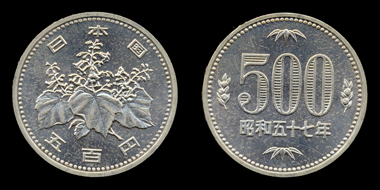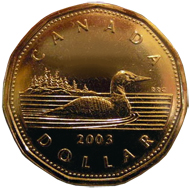by Richard Giedroyc
September 11, 2012 – Counterfeit Japanese 500-yen coins have been in the news recently, this being a continuing problem due to the high purchasing power of the coin. The Japanese 500 yen has had problems in the past as well, but for other reasons. The 1982 to 2000 coin make a good case study in why mints need to ensure a coin about to be introduced to circulation isn’t too similar to another coin already in use.
Japan 500 Yen, old version. Photo: As6673 / Wikipedia. Lizenz CCAS3.0 Unported.
A lack of due diligence in this area can be costly. Japan, as an example, eventually recalled and replaced the 500 yen of 1982 to 2000 with another 500 yen of a similar but different composition. The problem was that the 1982 to 2000 copper-nickel composition 26.5 millimeter diameter coin is identical both in metal composition and in diameter to the significantly lower value South Korea 500-won coin introduced the same year. The South Korean coin was worth about 50-yen at the exchange rate.
Japan 500 Yen, new version. Photo: Wikipedia.
Considering the close proximity of the two countries it didn’t take long before the South Korean coins began appearing in vending machines in Japan. The problem persisted until 2000 when Japan introduced a copper-nickel-zinc 500 yen. The addition of some zinc created a different electronic signature detectible by coin acceptance devices in Japan. Although this stopped the flood of South Korean coins into Japan the changeover to the new coin cost both the Mint of Japan and the domestic vending machine industry a significant amount of money to make the appropriate changes.
Japan may have been on the receiving end in this circumstance, but it was a Japanese coin that caused a similar problem in the United States. The Japanese bronze composition 10-yen coin first introduced in 1951 has a diameter of 23.5mm, very similar to the 24.3mm diameter copper-nickel composition US quarter dollar coin introduced in 1965 and its counterpart .900 fine silver quarter dollar issued prior to that date. The Japanese coin, with an exchange rate significantly lower than 25 US cents at the time, was unable to be detected in toll bridge and tunnel coin acceptance machines in the New York area for a time, once again costing the vendor a lot of money to recalibrate the machine mechanisms.
Coins of similar or identical weights, diameters, and metal compositions may be a problem when coins are vended rather than spent over the counter, but coins with similarities that have different electronic signatures still have to deal with the human factor when spent face to face with a merchant in commerce.
The average person does not study the coins in his or her possession. Despite government sponsored publicity regarding important information the public should know about a new circulating coinage issue the general public often fails to understand or distinguish the differences between coins in their hands.
The United Kingdom reduced the diameter and weight of its 5- and 10-pence coins during the early 1990s as a cost saving measure. The reduction of the diameter of the 10-pence coin from 28.5mm to 24.5mm made the denomination similar to the 23.59mm diameter 5-pence coin of 1968 to 1990 that was still in general circulation at the time. The newer 5-pence coin introduced in 1990 has a reduced diameter of 18.0mm, much easier to distinguish from the higher denomination than is its 1968 to 1990 predecessor.
Loonie 2003. Photo: Wikipedia.
US and Canadian 1-, 5-, 10-, and 25-cent coins have been intermingled in circulation within the United States for years. The US public fails to look at the differences in designs on the coins of the two nations, which otherwise are reasonably similar. There has been virtually no publicity surrounding more recent events, however a significant number of Canadian Loon dollar coins are now circulating in the United States as well. The Canadian Loon dollar was distinctly different in color from the circulation copper-nickel composition Susan B. Anthony and the much larger diameter Eisenhower dollar US coins. All this changed when the US introduced the Sacagawea dollar coin in 2000.
The aureate composition Loon dollar introduced in 1987 has a distinctive golden color and a 26.5mm diameter. The golden color US dollar issued since 2000 is composed of copper-zinc-manganese-nickel and has an identical diameter to its Canadian counterpart. At the time this article is being written the currencies of these two countries are approximately on par, but historically one has often been valued significantly higher than the other. The favorable or unfavorable currency exchange rates have encouraged the mixing of these two currencies on one side of the border or the other. The mixing of the two currencies is also a continuing problem for their banks, since neither US nor Canadian banks typically accept foreign coins.
This is far from being the first time the United States has failed to do its homework or simply ignored its own historic track record regarding coin emissions. In 1875 the US introduced a 22mm diameter 20-cent coin almost identical in design to the contemporary 24.3mm quarter. Both coins were composed of 90 percent silver. The 20-cent denomination was terminated three years later due to the confusion between the two. The quarter once again became the source of confusion when in 1979 the United States introduced its 26.5mm diameter Susan B. Anthony dollar coin, a coin with distinctively different design elements, but with a similar diameter and identical color to the existing quarter. The SBA dollar coin was only issued for four years due to the confusion it caused.
People simply identify coins by feel, color, and diameter. They do not usually look at the designs or read the legends identifying the country of origin or the denomination. The average non-collecting consumer does not examine their coins closely. This can be proved through the deceit propagated in the late 19th century by misrepresenting the US 1883 “Racketeer Nickel” 5-cent coin. This copper-nickel composition coin has a diameter of 21.2mm, with the head of Liberty on the obverse and a prominent Roman numeral V on the reverse representing five cents in value. The contemporary $5 Half Eagle gold coin has a diameter of 21.6mm, with a modestly different head of Liberty on the obverse, but an eagle on the reverse. The nickels were on occasion gold plated and passed successfully as $5 coins despite the significant design differences between the two coins!








